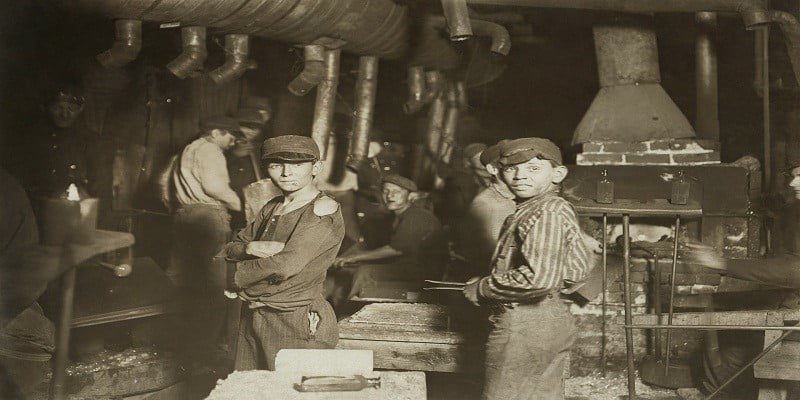Brief Introduction To Child Labour:
We all must have come across this quote, “The hands that were meant for holding books and pens are washing dishes and serving plates.” The said quotation is a stark reminder of Child Labor that exists in our society today. Simply put, Child Labour is the employment of Children in any work that interfere with their ability to attend schools and further deprive them of a happy Childhood. But there is more to it. Often, Children are forced to work without their willingness and exploitation is a common phenomenon in their workplace. Child Labor not only harms Children physically but mentally, morally and socially as well. The problem is bigger than it may appear.
Child Labour In Indian Context:
Child Labor is a pervasive problem, particularly in developing countries, though, no country is exempted. It exists almost everywhere in one form or the other. Historically, Child Labor was prevalent in North America and Europe in the 19th century following the industrial revolution. But it has declined rapidly in the 19th century. In the 20th century, regions such as Asia and Africa together account for more than 90% of the overall Child employment. Child Labor is rampant in Indian society and industrial space. The country is the home to the world largest number of Child Laborers in the world. As per India’s 2011 census, there were over 10.2 million Children involved in Child Labor in one form or the other. Of these, 5.6 million were boys and 4.5 million were girls, with nearly 8 million working in rural areas and over 2 million in urban areas.

Reasons Behind Child Labor:
Child Labor: Poverty’s Grim Consequence:
Lack of capacity to enforce minimum age requirement and poor schooling infrastructure are attributing to the growth of Child Labor in rural areas. Children work for many reasons. Lack of education, inadequate awareness and poverty are the major reasons for Child Labor. Often, parents of such Children push them to work owing to abject poverty. According to a study, over 60% of Children are pushed in Child Labour by their parents. Although, they are not paid well, yet their contribution to the family is significant in emerging countries. Another problem associated with Child Labor is that most of the Children are an unpaid family worker. Lack of proper schooling system also contributes to Child Labor.
Exploitative Work: Children Pay the Price:
Poor school infrastructure, overcrowding and absence of teachers make attendance a waste of time for Children and parents instead consider indulging their Children in some profitable work. Irrespective of reasons, Child Labors compounds discrimination and inequality and works as a great inhibitor to Children growth. Industries and personal employers take undue advantages for this workforce as Children don’t argue for a conducive work environment and better wages. According to the International Labour Office, Children work for the longest hour but they are paid less. They endure hazardous work conditions and face potential abuse. Although, legislation has been able to control the Child Labour informal sector to some extent, yet in informal and unmonitored rural sectors the problem is prevalent.
Laws To Curb Down Child Labor:
ILO: Safeguarding Children’s Rights:
Though most countries have laws to curb Child Labor, yet many Children do work. International Labour Organization (ILO) regulates the Labour for adults as well as the Child. ILO started in 1919 and currently has 186 member countries. The body under “Minimum Age Convention” states that person below the age of 18 cannot work in a facility that may compromise their safety, health and morals. Such works include mining, heavy manual Labour and operation of heavy machinery. Children aged above 13 may indulge in light work as long as that doesn’t hinder their education and health. Further, the law states that Children below the age of 13 are restricted from working.
Defining Child Labour: Global Challenge:
Apart from international law, different countries have their own regulation aimed at curbing Child Labor. I.e India’s Child and Adolescent Labour (Prohibition and Regulation) Act, 1986, amended in 2016, prohibits the employment of Children of age below 14 in any sorts of work including domestic help. However, a lack of international agreement on defining Child Labor and different age restrictions across the world is restraining the solution of the obvious problem. The majority will agree that a six or eight-year Child is too young to work, however, the same is debatable in case of twelve or fourteen-year Child. Until there is a mutual consent on defining Child Labor, it would be tough to abolish.

Future Course Of Action And Suggestions:
Combating Child Labour: Hopeful Measures:
Wonder, if there is a light at the end of this dark tunnel? There certainly is. Inclusive education and stringent regulations can restrain the growth of Child Labor. Although, these measures can yield a positive result, yet they prove ineffective in curbing this menace. Children won’t be encouraged enough to attend schools without any improvement in their economic conditions. The government must provide incentives to make up for their lost earnings. Introduction of the Midday Meal Scheme by the Government of India has yielded a positive result.
Education and Accountability: Fighting Child Labour:
Improving the quality of education in primary schools is the other effective measure that can help in manifesting the importance of education in parents’ mind. Governments and non-government organizations also need to focus on addressing the issue of Child trafficking. Focus on bridging the gap between the haves and have-nots along with addressing the socio-economic conditions of our society could be the way forward. Social auditing can play a vital role in keeping a check on such practices. Industries of all sorts should be made accountable for providing the corporate social performance of their employees. Further, there are some international standards that not only focus on curbing Child Labor but emphasizing on the wellbeing of employees of the organizations.
Progress Made, But Child Labor Persists:
Buyers often ask for such certifications to ensure that no unethical practice has been followed in the manufacturing of products. Thanks to the various initiatives, there has been a significant decline in Child Labor over the past years. As per the data, 152 million Children are involved in Child Labor in 2016 as compared to 246 million in 200. UNICEF further predicts that there would be nearly 152 million Children involved in Child Labor by 2025, of them, 52 million in hazardous work. The UNICEF works on preventing Child Labor by strengthening social service workforce. Although there are several regulatory bodies are upping their ante to reduce the Child Labor, however, a lot still needs to be done to end this menace.
**********
Disclaimer:- Views expressed are the author’s own.




